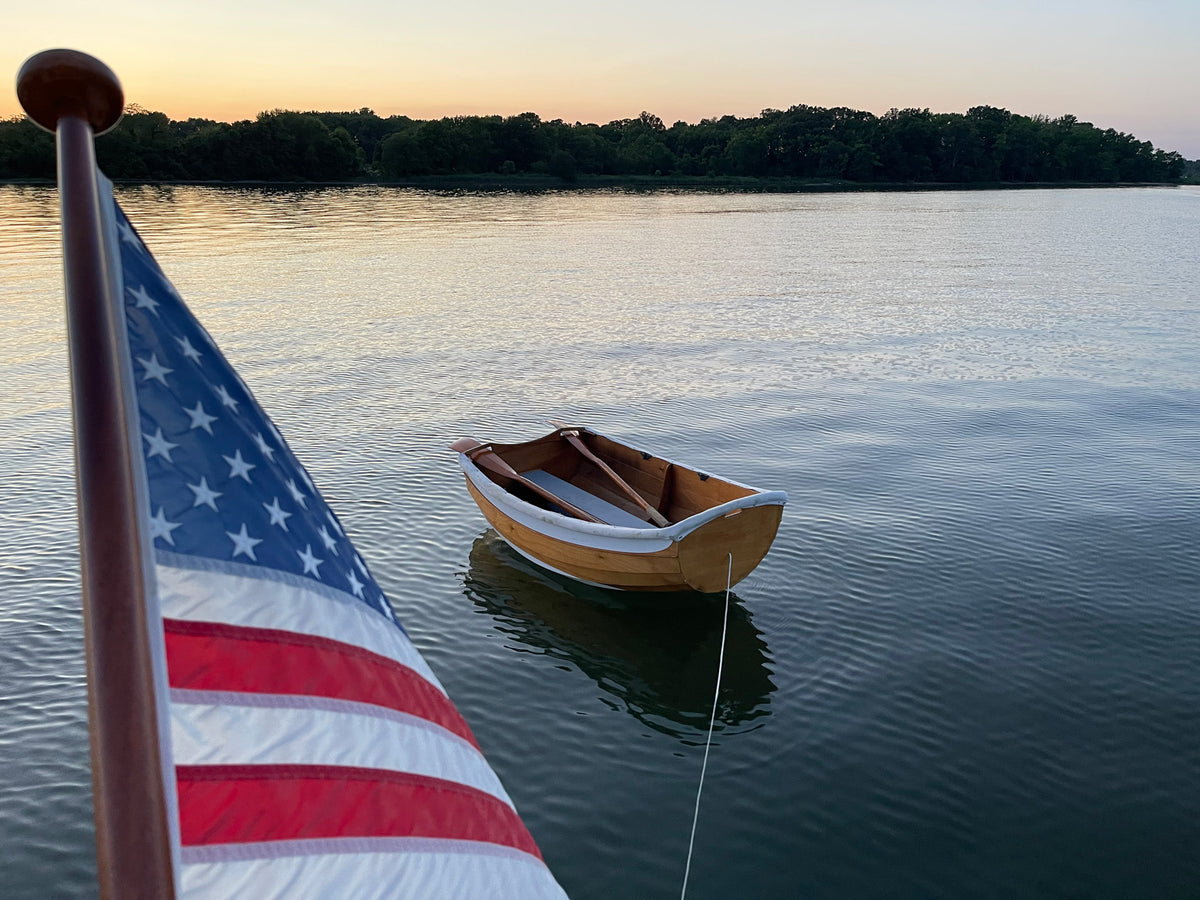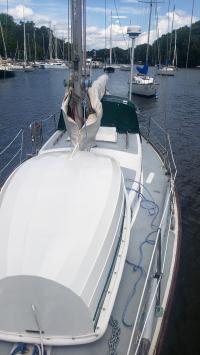Specifications
Performance
Stability
Speed
Cockpit Room
Payload
Ease of Construction

Overview
The Challenge:
Build-it-yourself dinghies have gotten prettier, lighter, and easier to build, with the 7'9" Eastport Pram a paragon of the type. A carefully-built Eastport Pram weighs around 65 lbs. though 70 lbs. is not uncommon with a bit of extra epoxy and accessories aboard. This is very light for its payload and strength, but it can be challenging to lift onto a car roof if you're tired or have a bad back. What to do? A small inflatable is a common solution. While those may be lighter, they are unattractive, awkward to move, and they make terrible rowing boats. Besides, purists simply prefer the aesthetics of a nice lapstrake dinghy.
The Solution:
Designer John Harris, a boatman and self-professed small-craft snob, has drawn up a fine miniature dink that will appeal to dinghy users with limited storage space and not-so-great upper body strength. Incorporating 21st-century technology, classical good looks, and boatbuilding techniques that we have evolved over two decades, the wood-epoxy Eastport Ultralight is a 38-pound, 6-foot-long pram with a 400-pound payload.
"At middle age, I'm just not as strong as I used to be," says John, "I needed a dinghy capable of holding two adults, a small child, and the groceries. Yet it had to be as light as a good kayak, so I could get it on and off the car top easily, or shift it from the dinghy racks at the marina to the launch spot, or lift it onto the foredeck of my small cruiser."
The Advantages:
"It probably helped that I wasn't expecting a whole lot of performance from such a tiny boat," John says. "But I've been delighted with what it can do. I can row the boat faster than I can walk, so a long pull across the harbor is just no big deal." Loads up to 400 pounds do not seem to slow it down any either.
The freeboard is high, actually an inch or two higher than the Eastport Pram's, which makes it harder for spray to get aboard and allows for a lot of reserve buoyancy. With six-foot oars you have so much power compared to the boat's weight and wetted surface that it seems unconcerned with windage. It tows light and dry when empty, with the bow transom well clear of the water.
Aside from its superb performance in the water, the ergonomics of the boat are excellent when portaging as well. You simply grab the centerline bench in one hand and hook the rail of the boat over your shoulder.
The boat is extremely easy to build. We assembled Hull No. 1 in a weekend, working in our booth at the 2015 WoodenBoat Show in Mystic. The CNC-cut hull parts quickly snap together like a jigsaw puzzle. We figure it is about a 50-hour project to do a nice job.
The Disadvantages:
First, there's no escaping the physics of a boat this small and light. Stepping aboard will not be like stepping into a Boston Whaler, or even a small inflatable. You need to be able to shift your weight in one smooth motion from dock or mothership to a seated position in the dinghy. Hesitate during the transfer of weight and the boat will slip out from under you like a banana peel. Use the same caution in embarking as you would in a canoe or a beamy kayak that weighs 40 pounds. It's entirely manageable if you're used to getting into boats with so little inertia, but someone going from a 140-pound inflatable to this dinghy might be startled and wet, in that order. There's plenty of stability once you're aboard, and especially once you're seated.
Second, beware of an important trade-off in keeping the weight down: there's no built-in flotation. The boat is wood so it's not going to sink if swamped, but it would be challenging to self-rescue. You could fit enough foam under the centerline bench to allow a wet rescue, and it wouldn't add much weight, but the foam could make it more difficult to carry the boat on shore (you lose that vital ergonomic hand-hold), and harder to place your feet near the centerline as you step aboard.
And finally, another compromise in creating an ultralight dinghy is that the thing is built with a thin hull shell. It's all 4mm plywood. The lower half of the hull is fiberglassed inside and out, while CLC's LapStitch™ joints provide stiffness to the topsides. It's rugged enough for casual usage, but some bad luck with a nasty bolt sticking out of a piling or a bad drop in the parking lot could cause damage. You'll have to exercise more caution in the dinghy park than you would with a bigger, heavier dinghy.
Kits for the Eastport Ultralight:
Kits are milled on our CNC machine from BS 1088 marine plywood, and wire holes are drilled for the stitch-and-glue assembly. Rails and trim are mahogany and cedar. Fiberglass is included for sheathing the inside and outside bottom of the hull, along with a complete epoxy kit. Copper wire and a pair of oarlocks and sockets are also included.

What builders are saying
Main Gallery
Line Drawings
Videos
Frequently Asked Questions
Take One of our Boatbuilding Classes
We offer classes for many of the boats we sell. Teaching sites stretch from Maryland to Washington State and from Maine to California. Click here to find out more.
View ClassesNeed Help Building it?
We’re here to help with any questions you might have during the build process.












































